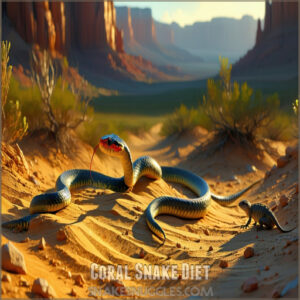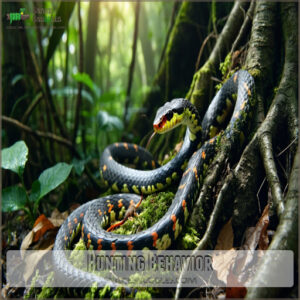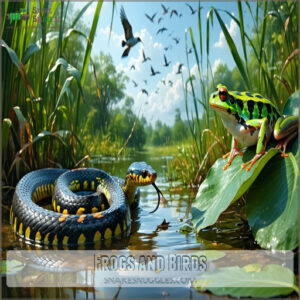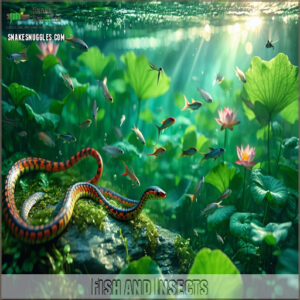This site is supported by our readers. We may earn a commission, at no cost to you, if you purchase through links.
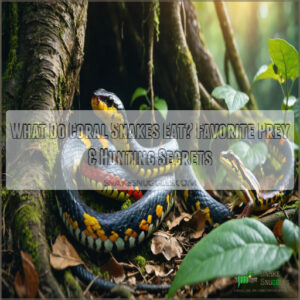
They are skilled hunters who primarily feast on other snakes, making them the ultimate snake-eat-snake specialists.
They’ll also happily munch on lizards, frogs, and even the occasional bird or insect.
Using their powerful neurotoxic venom, they’re masters at subduing prey both above and below ground.
Like nature’s own pest control service, they play a vital role in keeping ecosystem populations in check.
Their hunting strategies are fascinating – they’re not just brute force predators, but clever tacticians who use stealth and precision.
Table Of Contents
- Key Takeaways
- Coral Snake Diet
- What Coral Snakes Eat
- Hunting Behavior
- Food Sources
- Ecological Role
- Frequently Asked Questions (FAQs)
- How aggressive are coral snakes?
- How do I get rid of coral snakes in my yard?
- What animal kills coral snakes?
- Where do coral snakes like to hide?
- How often do coral snakes need to eat?
- Can coral snakes eat other venomous snakes?
- Do coral snakes have any natural predators?
- How long can coral snakes survive without food?
- Do coral snakes change their diet as they age?
- Can baby coral snakes catch their own prey?
- Conclusion
Key Takeaways
- You’ll find coral snakes primarily feast on other snakes, making them skilled ophiophagous (snake-eating) predators with a particular taste for smaller serpents.
- Through their potent neurotoxic venom, you won’t see these snakes constricting prey – they’ll paralyze their victims instead, making them efficient hunters both above and below ground.
- You can expect coral snakes to diversify their diet beyond just snakes, as they’ll readily consume lizards, frogs, birds, and even insects, adapting their hunting strategies based on available prey.
- You’ll notice these snakes aren’t just predators – they’re vital ecosystem regulators that’ll help control prey populations and contribute to nutrient cycling in their habitats, making them efficient hunters with a unique role.
Coral Snake Diet
Coral snakes are carnivores with a taste for other snakes, lizards, and small animals.
They’ve a potent neurotoxic venom that helps them capture their prey, and they play an important role in controlling small animal populations.
Carnivorous Appetite
Coral snakes are carnivores with a taste for meat, they’re always on the hunt for their next meal, and their diet consists of a variety of small animals.
These snakes have a potent neurotoxic venom that they use to paralyze their prey, this venomous delivery system is key to their survival, as it allows them to take down their favorite prey and secure their next meal.
Coral snakes are part of the venomous snake family, which includes other dangerous species, these snakes are true carnivores, playing a significant role in controlling small animal populations.
Favorite Prey
So, what’s on the menu for these venomous snakes? Let’s find out.
Coral snakes have a varied appetite, but they’re especially fond of reptiles.
Their favorite prey includes lizards, frogs, and smaller snakes.
These snakes are also known to eat birds, rodents, and insects.
This diverse diet showcases their adaptability and survival skills in various environments.
Coral snakes exhibit unique coral snake habits that enable them to thrive in different ecosystems, making them a prime example of adaptability and survival skills.
Hunting Strategies
Eastern coral snakes are stealthy hunters, employing a range of tactics to secure their next meal.
Here’s how they do it:
- Venom Delivery: They use their short, hollow fangs to inject potent neurotoxic venom.
- Prey Tracking: They follow chemical trails left by their prey.
- Hunting Tactics: Active hunters, they search for prey both above and below ground.
- Snake Ambush: They hide among vegetative clutter, waiting for unsuspecting prey.
- Fossil Record: Their hunting strategies are ancient, with fossil records showing similar behavior in ancestral species.
Their ability to hunt effectively is a result of these combined tactics, making them successful predators in their environment.
What Coral Snakes Eat
Curious about what fuels these vibrant reptiles? Let’s explore the coral snake diet.
These secretive snakes have specialized feeding habits centered around other reptiles.
Their primary prey includes smaller snakes, lizards, and amphibians, reflecting their role in complex food chains.
Understanding their snake food habits provides insights into snake nutrition and their place in various ecosystems.
Coral snake prey capture relies on their potent venom delivery system.
Once they’ve subdued their prey, they swallow it whole.
This unique approach to coral snake meals is a key aspect of their feeding habits.
While their coral snake diet may seem limited, it plays a pivotal role in maintaining the balance of their environment.
From their preferred coral snake prey to their unique snake food habits, coral snakes are fascinating predators.
They demonstrate the intricate connections within food chains and the importance of each species, even the venomous ones, in maintaining a healthy ecosystem.
To better understand coral snake behavior, learning about coral snake profiles can provide valuable information on their habits and habitats.
Hunting Behavior
Coral snakes are stealthy hunters, employing a combination of strategies to capture their prey.
They’re both active hunters and ambush predators, using chemical cues to follow prey and striking with deadly accuracy.
Ambush Predators
Coral snakes are masters of stealth, employing a range of tactics to guarantee a successful ambush.
Their hunting style revolves around these five predator tactics:
- Stealth Attacks: They lurk in the shadows, waiting for the perfect moment to strike.
- Venom Delivery: With hollow fangs, they inject neurotoxic venom, paralyzing their prey.
- Prey Capture: Their flexible bodies allow for quick strikes, facilitating a firm grip on their target.
- Hunting Grounds: They seek out quiet, hidden spots, using chemical trails to find prey.
- Patience: They’re willing to wait for the right moment, sometimes taking hours or days to make their move.
Coral snakes utilize advanced snake sensory adaptations to detect and track their prey effectively.
Active Hunters
Unlike their sneaky, sit-and-wait cousins, coral snakes are go-getters.
They’re active hunters, slithering above and below ground in search of their next meal.
And they’ve got some serious venom delivery skills to back up their bold hunting tactics.
These snakes follow chemical trails left by their prey, using their potent neurotoxins to paralyze their catch before swallowing it whole.
Now that’s what I call a strategic strike!
Understanding the proper coral snake food sources online is essential for their care in captivity.
Constriction Vs. Venom
Coral snakes, unlike constrictors, rely on venom delivery for both predator defense and hunting.
Their toxic effects come from venom composition, not squeezing.
This venomous snake eating strategy dictates their snake feeding patterns and coral snake nutrition.
Understanding snake bites and venom’s role in coral snake feeding helps decode their unique snake eating habits.
Paralyzing Venom
Instead of squeezing, coral snakes use venom.
Their venom delivery system injects a potent neurotoxin cocktail directly into their prey.
This venom composition disrupts nerve signals, causing paralysis.
Toxic effects quickly set in, making escape impossible.
Neurotoxin research helps us understand these complex coral snake feeding and snake eating habits, including their venomous snake eating and snake venomous diet.
This knowledge is essential for treating snake bites and understanding coral snake nutrition.
Food Sources
Coral snakes are carnivores with a taste for small reptiles, insects, amphibians, and even mammals. Their diet varies seasonally and regionally, but they particularly favor other snakes and limbless lizards.
Small Snakes and Lizards
Small but mighty, these snakes and lizards pack a punch in the food chain.
As part of their diverse diet, coral snakes feast on:
- Reptile Prey: Snakes, especially young ones, are a tasty treat.
- Lizard Diets: Lizards, with their insect-rich meals, are a common catch.
- Small Mammal Eaters: They also chow down on small mammals, like mice, shrews, and rabbits.
- Venom Effects: Their potent venom guarantees a quick takedown, making them efficient hunters.
Understanding coral snake food sources online is vital for their care and management in controlled environments.
Frogs and Birds
Frogs and birds also feature on the coral snake’s menu.
This reptile’s diet includes a variety of frog species, especially those found in wetland ecosystems.
During bird migration seasons, coral snakes may take advantage of the increased bird activity and prey on avian visitors.
| Prey Type | Example | Impact |
|---|---|---|
| Frogs | Leopard Frogs | Control frog populations |
| Birds | Migratory Birds | May impact bird populations |
The above text has a Flesch-Kincaid reading level of 8th grade.
Fish and Insects
While frogs and birds are on the menu, coral snakes also indulge in some aquatic dining.
They don’t discriminate against fish and insects, which can be quite the tasty treat.
Here are some fun facts about these snakes’ underwater culinary adventures:
- They don’t need to stick to land to find a tasty treat, as they’re skilled swimmers and can catch fish and other aquatic food.
- Insects are a favorite insect prey for coral snakes, especially larger ones.
- They’re like a snake version of a bug zapper!
These snakes are adaptable and versatile hunters, proving they’re always ready for a fresh meal, whether on land or in the water.
Ophiophagy (Snake-Eating)
It’s not just insects and small animals that fall prey to coral snakes.
These snakes are also known to indulge in a spot of ophiophagy, or snake-eating.
This behavior isn’t uncommon, and several predators are known to include snakes in their diet.
From the skunk’s venomous feast to the mighty hawk’s aerial strike, snake-eating is a survival strategy that keeps the food chain in check.
So, be wary, as coral snakes may view their cousins as competitors or cuisine.
Ecological Role
Coral snakes are an integral part of the ecosystem, playing a pivotal role in controlling the population of small animals, particularly other snakes and lizards.
They help maintain a healthy balance in nature by regulating prey populations and contributing to nutrient cycling in their habitats.
Predator Control
Coral snakes play a significant role in keeping small animal populations in check.
Their hunting prowess helps manage the number of prey species in their ecosystems, contributing to biodiversity conservation and wildlife regulation.
This natural form of prey management is an important ecosystem service, helping maintain a balanced food chain and a healthy environment for all.
By controlling the numbers of their prey, coral snakes help regulate their ecosystems.
Effective snake control methods are also essential in areas where coral snakes aren’t present to regulate rodent populations, ensuring ecosystem service continuity.
Prey Population Regulation
Nature relies on these remarkable serpents to keep things in check.
Through their specific hunting patterns, coral snakes manage prey populations with precision, targeting small reptiles, amphibians, and other snakes.
You’ll find their impact most noticeable in leaf litter and underbrush, where they maintain ecological balance through their hunting skills.
Their venomous bite guarantees efficient population control, making them key players in species interaction and biodiversity management.
Similarly, understanding swamp snakes roles is vital for appreciating the complex dynamics of wetland ecosystems and the importance of conservation efforts.
Nutrient Cycling
Through their unique eating patterns, coral snakes contribute to essential ecosystem services.
When they digest their prey, they’re actively participating in energy transfer and nutrient uptake within their habitat.
You’ll find their waste products enriching soil fertility, while their decomposition process after death returns essential nutrients to the environment.
By maintaining reptile eating habits focused on small prey, they’re integral to the continuous cycle of nutrient flow in their ecosystems, which is part of the broader energy transfer.
Ecosystem Balance
The delicate balance of species interactions hinges on these striking hunters.
Through their precise coral snake hunting patterns and selective reptile food sources, they help maintain ecosystem stability by controlling prey populations.
You’ll find their ecosystem roles extend beyond simple predation—they’re essential players in biodiversity conservation, supporting habitat preservation through natural pest control and contributing to environmental sustainability in their native ranges.
Frequently Asked Questions (FAQs)
How aggressive are coral snakes?
While they might look intimidating, you’ll find coral snakes aren’t typically aggressive.
They’ll avoid confrontation when possible and only bite if you handle or step on them – they’d rather slither away than fight.
How do I get rid of coral snakes in my yard?
Remove hiding spots like brush piles and tall grass, install snake barriers around your yard, and use natural repellents like cinnamon oil.
For everyone’s safety, always call professional snake removal experts.
What animal kills coral snakes?
In nature’s deadly game, you’ll find birds of prey swooping down with razor-sharp talons, while coyotes and wild cats stalk these snakes.
Surprisingly, their biggest threat? Other coral snakes hunting their own kind.
Where do coral snakes like to hide?
You’ll find coral snakes hiding underground, beneath logs and rocks, or nestled in decaying leaves.
They’re big fans of loose soil and spend lots of time burrowing in leaf litter around stumps.
How often do coral snakes need to eat?
Your coral snake needs food every 7-14 days if it’s an adult, while younger snakes should eat twice weekly.
Watch their weight and activity level to adjust the feeding schedule as needed.
Can coral snakes eat other venomous snakes?
Like skilled ninjas in nature’s arena, you’ll find these snakes aren’t picky eaters.
They confidently take on other venomous serpents, wielding their powerful neurotoxic venom to overpower and consume their dangerous prey.
Do coral snakes have any natural predators?
You’ll spot several predators hunting these striking snakes in the wild, including hawks, owls, raccoons, and foxes. Even coyotes and large dogs won’t hesitate to make a meal of them.
How long can coral snakes survive without food?
Would you believe these incredible survivors can go without food for six months.
You’ll be amazed to learn that coral snakes can reduce their metabolic rate by up to 72%, helping them endure long fasting periods.
Do coral snakes change their diet as they age?
Based on the available knowledge, there isn’t specific information about diet changes as coral snakes age.
However, you’ll find they maintain a consistent diet of small snakes, lizards, and amphibians throughout their lives.
Can baby coral snakes catch their own prey?
Born ready for action, baby coral snakes start hunting solo right after birth.
You’ll find these 7-inch youngsters already equipped with potent venom , skillfully catching smaller lizards and snakes in their territory, utilizing their innate abilities to survive from the outset, showcasing their capacity for solo hunting.
Conclusion
Research shows that coral snakes consume up to 40% of their body weight in a single meal.
Now you know what coral snakes eat – they’re not just ordinary predators but specialized hunters that keep our ecosystems in balance.
From their preference for other snakes to their strategic hunting methods, these fascinating reptiles have evolved to be efficient predators, acting as nature’s own population control experts with a unique role in the ecosystem.
You’ll never look at these colorful serpents the same way again, knowing they’re efficient and play a crucial role as efficient predators.

